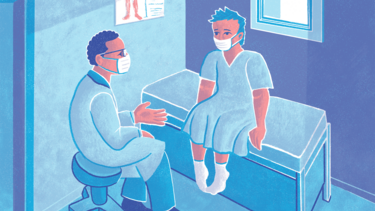Leading through COVID: Adapting Primary Care to a Pandemic
In this series, we talk with Yale SOM alumni about their professional and personal lives during the global pandemic. Dr. Frank Ciminiello ’19 explains how his medical practice has reconfigured to safely meet patients’ needs.
Q: What are you doing to cope, personally and professionally?
My wife and I have four kids. They are 7, 10, 12, and 14. We don’t have any help right now, so one of us is always home. In a dual-doctor household, we’ve always needed an open line of communication, but now it’s literally, “You’re on call today? All right, I will be on call tomorrow.”
I’m the vice president of a 75-doctor medical group in Trumbull, Connecticut. It is part of Yale New Haven Health. My wife is an obstetrician. There was no COVID planning nine months ago, so babies come when they come. She’s the essential worker in our household.
My work, traditionally, is 70% face-to-face with patients and 30% administration, but for 10 weeks we didn’t have any patients coming in person. We quickly built up our telehealth capabilities. And many of our doctors and nurse practitioners have volunteered to help out at hospitals as the hospitals’ loads have gotten heavier. I spent five weeks redeployed to two hospitals.
I was also part of taskforces that figured out how to reopen the practice. I was drawing on my business school education in figuring out how to operate within the constraints of social distancing including minimizing the time and number of people in the waiting room.
We reopened on June 1 as part of Connecticut’s phased reopening plan. Initially, we were about 30% capacity. We limited the number of clinicians seeing patients, and they weren’t seeing as many as they typically would.
Patients are screened for COVID symptoms in advance of their appointment. When they arrive at the office, we again ask the screening questions and do a temperature check.
Normally, I’d be seeing a patient in one room while my next patient would be getting their labs done in another. As I finished with the first patient, I go to the next room and another patient is brought in to start their labs. Our only constraints were delivering quality care and physician burnout. Now we have to let exam rooms sit empty after disinfection. It used to be with a routine office visit the doctor wasn’t wearing a mask. Now masks are a universal precaution and we have to be sure we’re not going through PPE too fast.
On July 1, we doubled the number of clinicians seeing patients in person even as we continued televisits. We’ve kept it at that level. From a clinician standpoint, we have the capacity to see more patients while keeping the waiting rooms essentially empty, but there’s a limit to how many patients our front desk staff can screen.
Their workload has perhaps doubled and rather than getting more streamlined, the screening has actually gotten longer as more states have become COVID hotspots. Because we had a couple people retire or move right before COVID, and since it was so hard to do interviews when the office was closed, the front office has remained a bottleneck for the moment.
“The pandemic has been hard on a lot of different types of people in a lot of different ways. And unless you ask and give them the opportunity to open up and talk about it, you might not hear it.”
Q: Does it feel different when you’re with patients?
It does. We’re wearing masks, so we’re eye to eye, but smiles and facial expressions are hidden. In primary care, a lot of it is the relationship. Now, there are no handshakes or hugs. It’s definitely different.
There’s a palpable difference in the atmosphere of the visits. People are concerned. People have become anxious or lonely or depressed during the time in isolation. Not everyone, certainly, but there’s clearly been an increase in mental health symptoms.
The pandemic has been hard on a lot of different types of people in a lot of different ways. And unless you ask and give them the opportunity to open up and talk about it, you might not hear it. Even though we have been increasing our number of face-to-face visits, it is still fewer patients per day than before the pandemic, so we have a little more time for each visit. Once you start talking to people, you hear a lot of things.
Q: What do you expect for the next phases of the pandemic?
I think that we’re going to be faced with tough decisions, again. We may not need another complete shutdown but partially closing down is a real possibility. Perhaps sooner than people might think. With people traveling for summer vacations and schools and colleges starting there’s the potential to bring it back to Connecticut and the Northeast.
As a practice, we’ve learned a lot. We are in a better position to adapt if we need to. We can take care of a lot of patients through telehealth. We hopefully have enough PPE that if we step back, we won’t have to completely shut down, but we may have to decrease the number of clinicians in the office and increase the PPE each clinician has.
Long term, if there’s treatments, that’s a game changer. But I think a vaccine is what it’ll take to get past this. I don’t think it will be available as fast as we want it to be, but I think we’ll get there. I trust the science.
